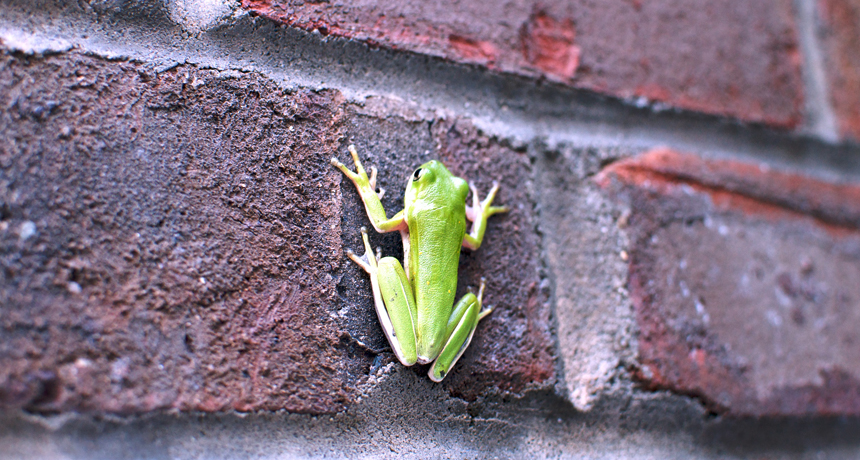What animal is the world’s best rock climber?

Lots of animals, such as this frog, manage to scale walls without any kind of the gear humans would need to accomplish such a feat.
sherbonbon/Flickr
- More than 2 years ago
What amazed me most about the video of rock-climbing bears that showed up on Gizmodo last week was not that the bears were climbing up vertical rock — it was their technique. I’ve been indoor rock-climbing for years, and I am not nearly as accomplished as these bears. And I’ve got special shoes, chalk for my hands and safety equipment to catch me should I lose my grip. But these bears climb like I was first taught, using the X-body position with three points of contact and never pulling themselves up with their front legs (or arms in my case). Maybe I should be watching more bear videos for tips.
The bears are good, but surely there are better rock-climbing animals out there. Which one is the best?
The contenders
Gecko: More than half of the world’s gecko species have special adhesive pads on their feet that let them cling to just about any surface and even hang and climb while upside down. The animals’ feet are covered with millions of tiny hairs called setae that stick to things via van der Waals interactions.
Snakes: If you’re trying to escape a snake, make sure you shut the windows in the house you hide in: Some snakes can scale walls. “A slithering snake gets a leg up from its scales, which provide much needed friction when moving forward,” Science Newsreported in 2009. A few years later, scientists discovered that snakes can actually control each tiny scale to increase that friction and help the animals climb.
Alpine Ibex: You might expect mountain-dwelling goats to be good mountain climbers. But the Alpine ibex that put their skills to use by climbing a near-vertical dam wall in Italy are pretty amazing. They scale the dam to lick the stone wall for salt. They accomplish this solely through their special feet: The hooves of these goats are split into two toes, each of which can act independently. Each toe is shaped like a parabola on the outside, which adds strength, and it’s cushy in the middle, so the toes can deform and shape themselves to match the surface. The ibex can even splay its toes to increase the contact area between its foot and whatever it’s trying to scale.
Spiders: The arachnids’ clingy talents can be attributed to their multitude of legs. Each leg is tipped with a slightly adhesive pad. An individual leg isn’t sticky enough on its own to keep a spider attached to a wall, but the combination of forces produced by opposite legs (such as the right back and left front) provides plenty of stickiness. Spiders, then, have to coordinate their leg action so they don’t fall, researchers reported January 15 in the Journal of Experimental Biology.
Snail: These animals employ a special, sticky mucus to adhere to vertical surfaces. When moving horizontally, a snail only needs the muscular pulses that travel through its single foot.
Tree frog: White’s tree frogs, scientists reported in 2009, have toe pads packed with “nanopillars” that generate friction. The frogs also produce an adhesive mucus. Together, the toe pads and mucus enable the frogs to stick to most things, though apparently they don’t do so well on rough, dry surfaces.
Baboon: In this video of baboons in Tanzania, you can watch the primates employ some pretty fancy climbing skills as they move to safety for the night. Employing a sort of advanced version of climbing as the bears mentioned above, the baboons are faster and make quick leaps between holds. The ability to climb rocks can provide a way for the animals to escape non-climbing predators. And some scientists have even theorized that such skills helped human ancestors to develop the ability to walk upright.
Catfish: Lithogenes wahari, a species of armored catfish found in remote Venezuela in 2009, has a sucker mouth and pelvic fins that can help the fish to climb vertical surfaces. Of course, those vertical surfaces have to be underwater, so this probably counts against it when considering climbing ability.
The verdict: My vote goes to the Alpine ibex (and it’s climbing goat kin) because even with special hooves, it seems like climbing would be a lot harder for them and, therefore, more impressive to me. Think another animal deserves the title of best rock climber? Cast your vote in the comments below.






